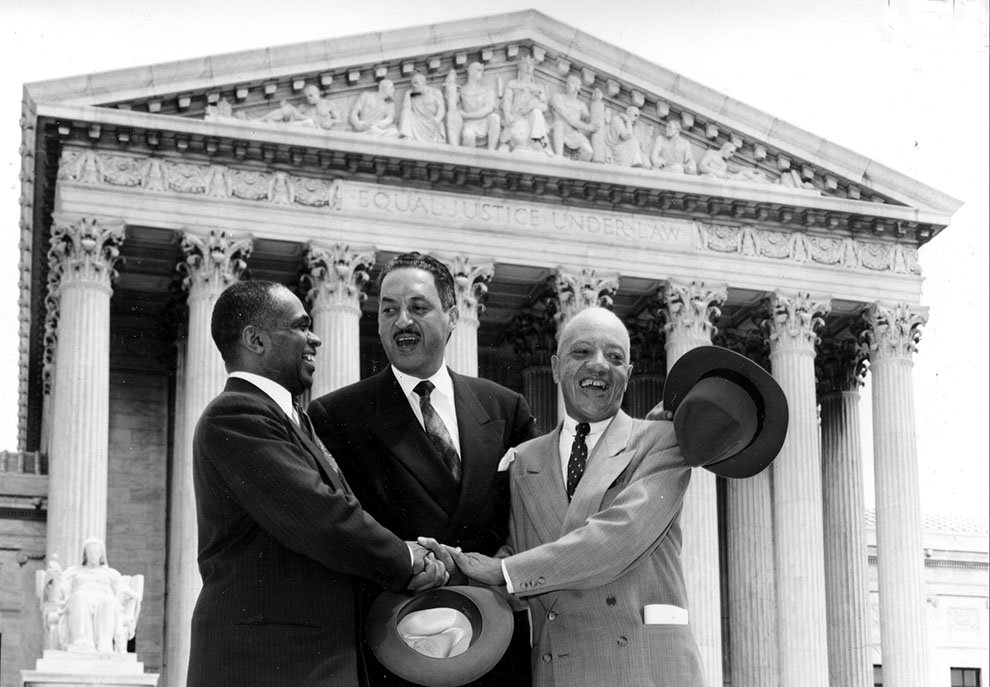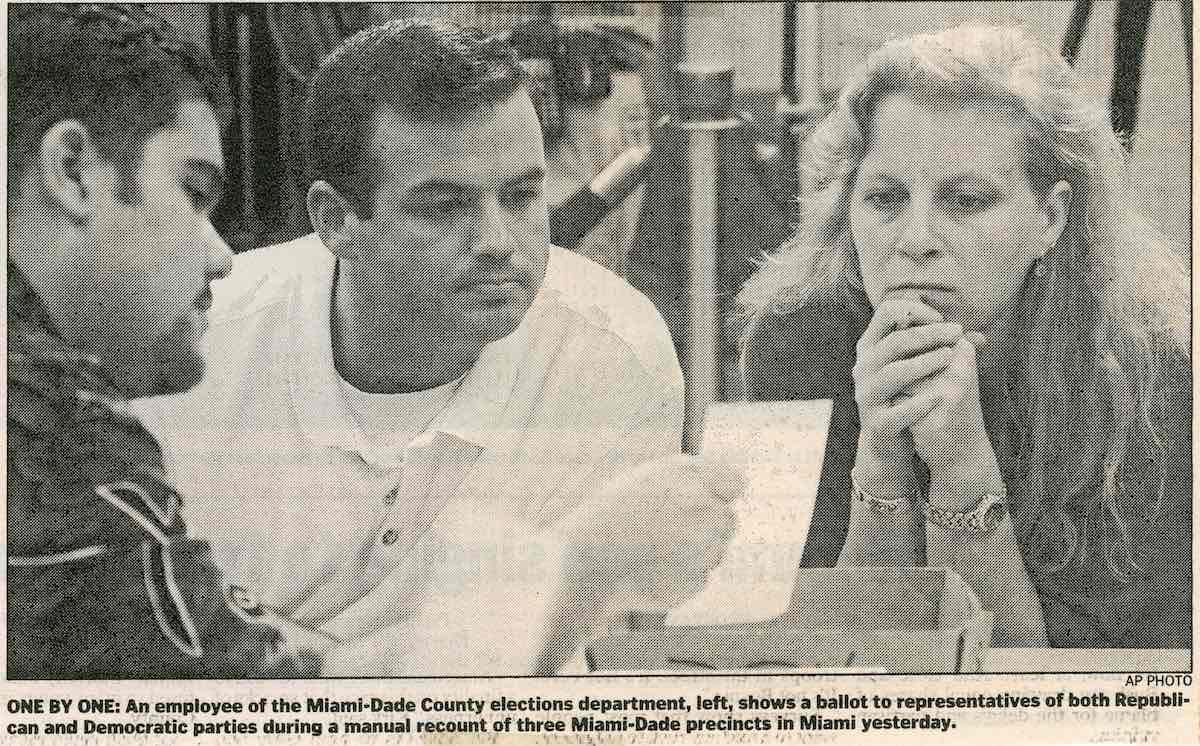The Most Important Constitutional Amendment You've Never Heard Of

Credit: No known copyright restriction
This amendment lies at the heart of issues on the left and right: abortion rights, gay marriage, contraceptive rights, gerrymandering, gun rights, affirmative action, resolving the Presidential Election of 2000, and the status of women in the draft. If you care about any of these subjects, no matter you opinion, you have to understand the constitutional amendment at the center all of those debates in order to have an informed opinion. It is the most influential part of the constitution on daily life. It’s not any of the Bill of Rights; They actually had a legal loophole that this amendment would close.
Can you guess what it is?
I am of course, referring to the Fourteenth Amendment. The Fourteenth is unique even among other “freedom granting” amendments because it does not protect any specific liberty (for example, freedom of speech); Instead it protects liberty in general. As a consequence, it has been used to give us liberties that its framers could never have imagined, such as access to contraception. This opens the door for a non-legislative policy response to unequal institutions, like money bail, when state and federal legislatures are too gridlocked to act. But to get there, we have to start with the historical context.
Historical Context (briefly)
The North won the Civil War and outlawed slavery in the Thirteenth Amendment (finally). Being nominally free wasn’t enough; abolitionists realized that they needed protection from persecution by the government and other citizens. They legislated the Fourteenth Amendment to protect newly freed slaves, but its provisions protect all Americans, so it has huge implications for society today. There are three important clauses I will discuss: the Privileges and Immunities Clause, the Due Process Clause, and the Equal Protection Clause.
Privileges and Immunities Clause
I am not a legal scholar or historian, so I may have mistakes; feel free to mention them in the comments.
The Bill of Rights is the first ten amendments to the constitution, which guarantees a litany of rights including:
- Freedom of religion
- Freedom of speech
- Right to bear arms
- And others
However, all of these limitations on governmental action only apply to the federal government not state governments (confirmed by Barron v. Baltimore. The framers largely trusted the state governments and were only skeptical of a tyrannical federal government for three reasons:
The idea of the thirteen former colonies operating as a single nation was still new. They volunteered to work together in the Revolutionary War and then in the Articles of Confederation, but still mostly operated as a loose confederation of states while the Constitution was being drafted.
State governments were directly elected, while many parts of the federal government were indirectly elected or appointed (the Senate, the President, the Supreme Court, other federal courts, the cabinet, etc.).
The seat of federal power was distant given the modes of transportation available at the time, but the state capitol was usually only a few days away by horseback.
In general, the state governments were responsive to the people… as long as “the people” were white and male. Abolitionists in the North saw that the South couldn’t be trusted to be anything but tyrannical to the newly-freed slaves. The framers of the Fourteenth Amendment in 1868 set out to rectify what the framers of the Bill of Rights in 1789 overlooked: the Constitution would need to limit state governments in order to preserve civil liberties for all Americans.
No State shall make or enforce any law which shall abridge the privileges or immunities of citizens of the United States;
However, the effect of this clause all hinges on how one defines “privileges and immunities.” The framers intended to include the Bill of Rights and other rights, but they did not want to enumerate them lest the amendment be limited to only the Bill of Rights. However, this plan backfired: in a 5-4 decision known as The Slaughter-House Cases (1873), the Supreme Court interpreted “privileges and immunities” narrowly, not even including the Bill of Rights! This single decision renders the whole clause nearly irrelevant, and it is rarely used today.
Yale Law Professor Akhil Amar wrote “virtually no serious modern scholar—left, right, and center—thinks that Slaughter-House is a plausible reading of the [Fourteenth] Amendment.” The Court usually gives deference to the intention of the framers, and in this case, the Congressional record itself holds their discussion that they intended the Amendment protect the Bill of Rights! Unfortunately, once the Court settles on something, it is extremely difficult to reverse, due to a doctrine known as stare decisis. Instead, legal advocates would turn to the Due Process Clause to provide the basic freedoms of the Bill of Rights for the newly-freed slaves.
However, there are some signs that almost a hundred-and-fifty years later, the court is willing to revisit this decision. Justice Clarence Thomas in McDonald v. City of Chicago (which I will describe later), used the Privileges and Immunities Clause to arrive at his decision, indicating he may be willing to overrule Slaughter-House in the future.
Due Process Clause
nor shall any State deprive any person of life, liberty, or property, without due process of law;
 The most obvious application is to criminal proceedings, where alleged
criminals are guaranteed a legal procedure to defend
themselves. But it also extends to things like eminent domain: if the Vogons
want to knock down Arthur Dent’s property to build an intergalactic
hyperspace bypass, the Amendment would require that they notify
Arthur Dent (and the other residents of earth) and provide a legal
procedure to fight the demolition. Leaving a note at Alpha Centauri
doesn’t count.
The most obvious application is to criminal proceedings, where alleged
criminals are guaranteed a legal procedure to defend
themselves. But it also extends to things like eminent domain: if the Vogons
want to knock down Arthur Dent’s property to build an intergalactic
hyperspace bypass, the Amendment would require that they notify
Arthur Dent (and the other residents of earth) and provide a legal
procedure to fight the demolition. Leaving a note at Alpha Centauri
doesn’t count.
Hence, this category of rights is called procedural due process. The exact legal procedure to which we are entitled depends on the circumstance. For example, those accused of violating criminal laws are entitled to a procedure in which they can argue their innocence.
But what if a state made a law saying everyone whose first and last name starts with an ‘A’ needs to pay a fine to the government? Procedural due process wouldn’t help Aziz Ansari, because he is clealy guilty of having an A-name. In order to really have due process, the Court decided, the government needs to prove that the law is not an arbitrary limitation of freedom. This is caled substantive due process, because it protects people from the substance law. In order to get the highest level of protection, “strict scrutiny,” from the Due Process Clause, plaintiffs have to show two things:
- The government encroaches a right that is “deeply rooted in our nation’s history and traditions.”
- That encroachment is not “narrowly tailored to serve a compelling state interest.”
Judicial review, the practice of the judiciary striking down some law as unconstitutional, is not without controversy. It is inherently “anti-majoritarian:” a small group of appointed political elites can overturn the will of the people and their elected legislature. The point of judicial review is to check the power of popular will against narrowly and explicitly defined legal precepts; if 50.01% of people decide to oppress the other 49.99% for no reason, the courts should be able to prevent that. However, the courts are rightly reluctant to be in the position of overturning the popular will.
The considered views and opinions of even the most highly qualified scholars and experts seldom outweigh the determinations of the voters. When challenged, however, the voters’ determinations must find at least some support in evidence. —Judge Vaughn Walker in Hollingsworth v. Perry (2010)
Incorporating the Bill of Rights against the states
Instead of the Privileges and Immunities Clause incorporating all of the Bill of Rights against the states, as the framers intended, the Supreme Court chose to incorporate individual pieces of the Bill of Rights against the states on a case-by-case basis. Overtime most—but not all—of the Bill of Rights has been incoprorated (for a list of each amendment and its incorporation status, see here). The most important for contemporary political descussion is McDonald v. City of Chicago (2010) because it deals with gun rights.
Prior to this case, it was an open question whether the Second Amendment applied to states; Chicago assumed it did not and enacted restrictive gun control, completely banning handguns. The plaintiff stated that his home had been broken into multiple times, so he needed a handgun to ensure his own liberty. Even the gun control advocates must admit, owning a gun is “deeply rooted in our nation’s history,” and a blanket ban on handguns is not a “narrowly tailored” restriction. By this logic, the Court struck down Chicago’s ordinance and decided the Second Amendment does apply to the states. The Court does permit some regulation of guns.
Chicago can amend its gun laws to comply with this ruling while continuing to have strong, comprehensive and Constitutional gun laws, just as Washington D.C. has done [following District of Columbia v. Heller (2008)]. — Justice Samuel Alito in McDonald v. City of Chicago
Even the Brady Campaign Against Gun Violence claimed victory following McDonald, because the Court clarified what gun legislation was constitutional, and that includes many policies the Campaign advocates for.
Equal Protection Clause
nor deny to any person within its jurisdiction the equal protection of the laws;
The abolitionists expected that state governments would not start treating the newly-freed slaves equally overnight. Hence, they wrote the Equal Protection Clause. Given this, how could segregation have existed for so long in the South?
The Supreme Court again minimized the impact of the Fourteenth Amendment, to the point where the most egregious segregation was legal, in four major decisions:
The Supreme Court noted in U.S. v. Cruikshank (1876), upheld in Civil Rights Cases (1883), that the Fourteenth Amendment only limits state governments not individuals; the relevant sentence of the Amendment begins “No state shall…” Private restaurants, hotels, and trains could—and did—exercise discrimination.
The Court ruled in Breedlove v. Suttles (1937) that since the rules for the poll tax were applied uniformly, it is consistent with the Equal Protection Clause. It just so happens that these rules disadvantage certain racial classes.
The Court ruled in Lassiter v. Northampton County Board of Elections (1959) that a literacy test was consistent with Equal Protection Clause as long as it was not intended to descriminate on the basis of race. Of course, courts rarely found such “intent” in the law.
The Court, infamously, asserted in Plessy v. Furguson (1896) that “separate but equal” segregation is consistent with the Equal Protection Clause.
For these reasons, the Amendment failed to live up to its goals. There were violations of even the watered-down Amendment: certainly some of the literacy tests were intended to descriminate on the basis of race, and certainly there were government-provided services which were separate but unequal. But extra-legal factors prevented challenges to the system of segregation. I consider it the greatest moral failing of the American justice system that even the limited guarantees of the Amendment were not provided to blacks in practice.
However, this was to be redeemed during the civil rights movement in the mid-twentieth century. Each of the legal defects would be completely reversed.
Lyndon Baines Johnson signed the The Civil Rights Act of 1964, justifying its authority to desegregate private industries because on the Commerce Clause (segregation affected interestate commerce) rather than the Fourteenth Amendment. This was upheld in the landmark Heart of Atlanta Motel, Inc. v. United States (1964) and led to the reluctant disappearance of de jure segregation from the United States.
The Twenty-fourth Amendment (1964) made poll taxes unconstitutional for federal elections and Harper v. Virginia State Board of Elections (1966) did so for state and local ones. As far as I can tell, the court in Harper arrived at a different conclusion because it consisted of different justices than in Breedlove, thirty years prior.
In Katzenbach v. Morgan (1966), the Court expanded a part of the Fourteenth Amendment I have not elaborated here (the Enforcement Clause) which would permit the Civil Rights Act of 1964 to prohibit literacy tests.
The infamous “separate but equal” doctrine was struck down in Brown v. Board of Education (1954). I could write a whole essay just on the difference between in the Court’s reasoning in Plessy and Brown, but the briefest summary is: the plaintiffs argued that “separate educational facilities are inherently unequal.”
It makes me imagine what would the country look like if the Fourteenth Amendment was interpreted and drafted as it intended. What if the Jim Crow Era never happened? In a few ways, American society still hasn’t made up the progress gained in the height of Reconstruction—of course, we have surpassed it in many other ways. The occupying Northern Army took a stand against racial violence and had even eradicated the First KKK all the way back in 1871! Many states and districts have yet to send a black person to congress since Reconstruction. When they have, there is usually only just one.
And despite these recent legal victories, of course the fight against racism is not over. It has largely pivoted to social, cultural, and economic issues, rather than de jure segregation. We will see how the Fourteenth Amendment is still a part of this fight, as reformists are trying to use it to abolish money bail.
Sexual Equality and the Fourteenth Amendment
The Amendment never explicitly mentions sex discrimination, but it seems an obvious consideration for the Equal Protection Clause. Again, the courts would interpret the Amendment narrowly; It would take almost a century to ensure that sex discrimination is protected, and in some ways, the fight is still continuing today.
Susan B. Anthony wanted to argue that she was a citizen by birth and that the right to vote was a privilege of citizenship. Therefore, it should be extended to her by the Privileges and Immunities Clause. However, Anthony could not get even this far. The authorities considered her voting a criminal violation rather than a civil one, so United States v. Susan B. Anthony (1873) could not even come before the Supreme Court. Her jury of peers was all male; Anthony remarked this paradoxically implies men are peers of Anthony even while they had a right she didn’t. To top it off, the presiding judge, Justice Ward Hunt, actually instructed the jury to find Anthony guilty. A contemporary observer would remark, “Miss Anthony had no trial by jury. She had only a trial by Judge Hunt.”
Even contemporary observers realized the Anthony trial was little more than political theatre. Suffragists tried again in Minor v. Happersett (1875). The judge ruled that voting was not a privilege of citizenship. After all, some children and felons are certainly citizens but none of them cannot vote. This case had a ripple effect in limit suffrage in Breedlove and Lassiter. Women would need a constitutional amendment to claim the right to vote instead, which they got in the Nineteenth Amendment (1920).
 In 1971, almost a hundred years after the first failed attempt to apply
the Fourteenth Amendment to sexual equality by Anthony and
Minor, the Supreme Court heard Reed v. Reed
(1971). Idaho had a law that privileged men over women in
deciding inheritance. The plaintiffs argued this violated their Equal
Protection Clause, and the Court agreed. Coincidentally, Ruth Bader
Ginsberg submitted an amicus brief to the Supreme Court she would later
be appointed to.
In 1971, almost a hundred years after the first failed attempt to apply
the Fourteenth Amendment to sexual equality by Anthony and
Minor, the Supreme Court heard Reed v. Reed
(1971). Idaho had a law that privileged men over women in
deciding inheritance. The plaintiffs argued this violated their Equal
Protection Clause, and the Court agreed. Coincidentally, Ruth Bader
Ginsberg submitted an amicus brief to the Supreme Court she would later
be appointed to.
Since then, sex is protected by the Equal Protection Clause with “intermediate scrutiny,” which is some progress, but many want to pass the Equal Rights Amendment which would would protect sex at the highest level, “strict scrutiny,” making it easier to win cases based on sexual discrimination (see ERA Education Project). However, requiring only males to register for the draft would not pass strict scrutiny, even according tolegal scholars who favor the ERA (Hastings Law Journal). This was the source of much opposition at the time the ERA was debated, since the feminist movement was linked with the anti-Vietnam War movement. Today, 76% of women support the ERA according to a 2020 AP poll, but only 38% of women agree with extending draft registration to women according to a 2020 Rasmussen Report. As such, many feminists want to pass the ERA and abolish the draft.
To add yet another complexity, a male-only draft-registration might not even pass the currently-enforced intermediate scrutiny. The challenge will probably fail, but we won’t know for sure until the courts decide appeals on National Coalition for Men v. Selective Service System (2019). Feminist advocates such as the National Organization for Women Foundation are actually aligned with the National Coalition for Men, because such a ruling would strengthen the definition of intermediate scrutiny under the Equal Protection Clause.
In Blostock v. Clayton County (2020), the court would expand discrimination the definition of “sexual discrimination” to include discrimination based on sexual preference and sexual identity. This was argued in the context of Title VII of the Civil Rights Act Neil Gorsuch justifies the expansion as such:
An employer who fired an individual for being homosexual or transgender fires that person for traits or actions it would not have questioned in members of a different sex. Sex plays a necessary and undisguisable role in the decision, exactly what Title VII forbids. Those who adopted the Civil Rights Act might not have anticipated their work would lead to this particular result. But the limits of the drafters’ imagination supply no reason to ignore the law’s demands.
—Neil Gorsuch in the majority opinion of Bostock
The Fourteenth Amendment Today
The Amendment has implications for a host of policy issues today.
Marriage rights: Loving v. Virginia (1967) extended marriage rights to inter-racial couples, while Obergefell v. Hodges (2015) did so for same-sex couples, both on the basis of the Equal Protection Clause.
 Griswold
v. Connecticut (1965) provided contraceptive rights while Roe v. Wade
(1973) and Planned
Parenthood v. Casey (1992) provided abortion rights, under
certain conditions. The Court found an implied right to
privacy, protected by the Due Process Clause, that makes blanket bans on
contraception and abortion unconstitutional. The Court permitted some
restrictions on abortion so long as they do not create an “undue
burden” on the woman seeking an abortion.
Griswold
v. Connecticut (1965) provided contraceptive rights while Roe v. Wade
(1973) and Planned
Parenthood v. Casey (1992) provided abortion rights, under
certain conditions. The Court found an implied right to
privacy, protected by the Due Process Clause, that makes blanket bans on
contraception and abortion unconstitutional. The Court permitted some
restrictions on abortion so long as they do not create an “undue
burden” on the woman seeking an abortion.
Challenges to affirmative action: The Court found that affirmative action, in general was ok, but racial quotas were a violation of the Equal Protection Clause in Regents of the Univ. of Cal. v. Bakke (1978).
Trump’s Presidential Advisory Commission on Election Integrity: The commission wanted to compare voter rolls to a database of non-citizens. The NAACP claimed that this would have a large amount of false-positives, and that would disproportionately affect minorities and violate the Equal Protection Clause, in NAACP Legal Defense and Education Fund v. Trump, Pence, and Kobach (2017). The Commission was dismissed before the case went to court.
The Presidential Election of 2000: The Court held that Florida’s statewide recount did not enforce equal standards on each county, so it was a violation of the Equal Protection Clause in Bush v. Gore (2000). Bush won the original count by hundreds of votes (about 10-6 of the total), and with the recount invalid, George Bush became the 43rd President of the United States.
 Gerrymandering: The Court almost outlawed
gerrymandering in Davis v.
Bandemer (1986) under the Equal Protection Clause but later
found that no metric for deciding if a district map was gerrymandered
was suitable in Vieth v.
Jubelirer (2004). Even so, gerrymandering along racial lines
was prohibited League
of United Latin-American Citizens v. Perry (2006), if a map did
not include enough majority-minority districts.
Gerrymandering: The Court almost outlawed
gerrymandering in Davis v.
Bandemer (1986) under the Equal Protection Clause but later
found that no metric for deciding if a district map was gerrymandered
was suitable in Vieth v.
Jubelirer (2004). Even so, gerrymandering along racial lines
was prohibited League
of United Latin-American Citizens v. Perry (2006), if a map did
not include enough majority-minority districts.
Money bail: There is an as-yet undecided case called O’Donnel v. Harris County which alleges that the bail system used in most of Houston, TX unfairly discriminates on the basis of wealth when more reasonable alternatives are available.
Takeaways
In school, I had to memorize the preamble and was quizzed on the Bill of Rights. The preamble has little bearing on understanding how the government functions today, and the Fourteenth Amendment has had an arguably greater impact on my life than the Bill of Rights by itself. Investigation of it leads to several important lessons about liberty and our constitution:
The fight for the civil liberties for a specific group is fundamentally intertwined with the fight for freedom for everyone. The Fourteenth Amendment, designed to protect newly-freed slaves is what protects the right to bear arms, freedom from sexual discrimination, and countless others.
The fight for racial equality isn’t just the Civil War or Brown v. Board. The fight for gender equality isn’t just The Nineteenth Amendment or The Civil Rights Act. These would evolve over multiple centuries in a patchwork-quilt of legislative, judicial, executive, social, and cultural battles. The struggle is by no means linear and by no means won. We are still fighting the descendants of the same fight today.
The American Constitution is a living document. At its surface, it has been changed the constitutional amendments like the Fourteenth, but, more subtly, the courts change it through case law. Plessy and later Brown fundamentally changed how we interpret the Equal Protection Clause. I was surprised to learn how many landmark cases were only decided recently (McDonald (2010), Obergefell (2015), Blostock (2020)). I think the strength of the constitution is that it can be adapted to suit the novel challenges of modern society.